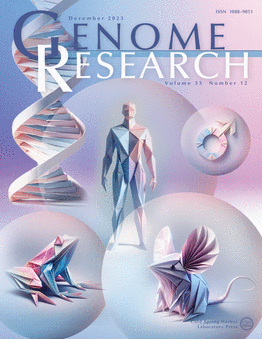乳腺癌中esr1驱动增强子的综合功能注释揭示了独立于基因组和表观基因组背景的分层活性
IF 5.5
2区 生物学
Q1 BIOCHEMISTRY & MOLECULAR BIOLOGY
引用次数: 0
摘要
雌激素受体1;也被称为ERα,由ESR1基因编码)是乳腺癌发生和进展的驱动转录因子。ESR1的基因组作用被认为是在严格的表观遗传控制下运作的,其染色质结合和随后的转录输出严重依赖于先驱转录因子FOXA1, FOXA1使ESR1的染色质可以结合。然而,表观基因组对ESR1选择性增强子激活的确切贡献仍有待完全阐明。为了解决这个问题,我们采用了一种大规模平行报告基因分析方法来分析7576个ESR1结合位点的激素反应性。只有少数esr1占据的增强子表现出激素诱导的活性。这些发现得到了原位基因组数据的证实,表明在染色质化背景下增强子的激活在基于质粒的报告基因分析中得到了强有力的捕获。我们的研究结果与来自乳腺癌细胞系和肿瘤样本的公开可用功能基因组学数据集进行了计算机集成,揭示了不同类型的ESR1结合位点的不同转录复合物组成、3D基因组背景和调控动力学。总的来说,我们的研究结果建立了一个全面的框架,以强调和阐明ESR1基因组异质性的分子基础及其对乳腺癌生物学和临床结果的贡献。本文章由计算机程序翻译,如有差异,请以英文原文为准。
Comprehensive functional annotation of ESR1-driven enhancers in breast cancer reveals hierarchical activity independent of genomic and epigenomic contexts
Estrogen receptor 1 (ESR1; also known as ERα, encoded by ESR1 gene) is the driving transcription factor in breast cancer development and progression. ESR1 genomic action is thought to operate under tight epigenetic control, with its chromatin binding and subsequent transcriptional output heavily reliant on the pioneer transcription factor FOXA1, which renders chromatin accessible for ESR1 binding. However, the exact contribution of the epigenome to selective enhancer activation by ESR1 remains to be fully elucidated. To address this, we employ a massively parallel reporter assay to profile 7576 individual ESR1 binding sites for hormone responsiveness. Only a minority of ESR1-occupied enhancers exhibit hormone-induced activity. These findings are confirmed by genomic data in situ, indicating that enhancer activation within a chromatinized context is robustly captured in a plasmid-based reporter assay. In silico integration of our findings with publicly available functional genomics data sets from breast cancer cell lines and tumor samples reveal distinct transcription complex compositions, 3D genome contexts, and regulatory dynamics associated with different classes of ESR1 binding sites. Overall, our results establish a comprehensive framework to highlight and elucidate the molecular basis underlying ESR1 genomic heterogeneity and its contribution to breast cancer biology and clinical outcomes.
求助全文
通过发布文献求助,成功后即可免费获取论文全文。
去求助
来源期刊

Genome research
生物-生化与分子生物学
CiteScore
12.40
自引率
1.40%
发文量
140
审稿时长
6 months
期刊介绍:
Launched in 1995, Genome Research is an international, continuously published, peer-reviewed journal that focuses on research that provides novel insights into the genome biology of all organisms, including advances in genomic medicine.
Among the topics considered by the journal are genome structure and function, comparative genomics, molecular evolution, genome-scale quantitative and population genetics, proteomics, epigenomics, and systems biology. The journal also features exciting gene discoveries and reports of cutting-edge computational biology and high-throughput methodologies.
New data in these areas are published as research papers, or methods and resource reports that provide novel information on technologies or tools that will be of interest to a broad readership. Complete data sets are presented electronically on the journal''s web site where appropriate. The journal also provides Reviews, Perspectives, and Insight/Outlook articles, which present commentary on the latest advances published both here and elsewhere, placing such progress in its broader biological context.
 求助内容:
求助内容: 应助结果提醒方式:
应助结果提醒方式:


